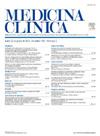Fecal occult blood is associated with an increased risk of cerebral small vessel disease in elderly patients
IF 2.6
4区 医学
Q1 MEDICINE, GENERAL & INTERNAL
引用次数: 0
Abstract
Background and purpose
Studies have shown that fecal occult blood is associated with an increased risk of ischemic stroke, but the relationship between fecal occult blood and cerebral small vessel disease (CSVD) remains largely unknown. This study aimed to identify predictors for CSVD, with fecal occult blood and its proxies as potential influencing factors in elderly patients.
Method
Patients aged 65 years or older with various chronic diseases were enrolled. The presence of CSVD was evaluated by brain MRI results. Fecal occult blood was measured by fecal immunochemical test. Logistic regression analysis was used for the association between the presence of fecal occult blood and the risk of CSVD.
Results
Logistic regression analysis indicated that a prevalence of positive fecal occult blood was related to CSVD (Model 1, adjusted OR = 1.63, 95% CI: 1.15–2.29, P = 0.006). We subsequently grouped all subjects as positive fecal occult blood (259, 16.48%) and negative fecal occult blood (1313, 83.52%), and logistic regression analysis indicated that a prevalence of CSVD was related to positive fecal occult blood (Model 2, adjusted OR = 1.50, 95% CI: 1.08–2.08, P = 0.015). In addition, the ratios of lacunes (67.18% vs. 53.85%, P < 0.001) and enlarged perivascular spaces (43.63% vs. 34.42%, P = 0.005) were higher in patients with positive fecal occult blood than in controls.
Conclusions
The presence of fecal occult blood is probably related to the risk of CSVD in elderly patients and could be used as a screening tool for CSVD in elderly populations.
老年患者粪便隐血与脑血管疾病风险增加相关。
背景和目的:研究表明,粪便隐血与缺血性卒中风险增加有关,但粪便隐血与脑血管病(CSVD)之间的关系仍不清楚。本研究旨在确定老年患者CSVD的预测因素,其中粪便隐血及其代用品是潜在的影响因素。方法:选取年龄在65岁及以上的慢性疾病患者。通过脑MRI结果评估CSVD的存在。采用粪便免疫化学法测定粪便隐血。采用Logistic回归分析粪便隐血与心血管疾病风险之间的关系。结果:Logistic回归分析显示,粪便隐血阳性患病率与CSVD相关(模型1,校正OR=1.63, 95% CI: 1.15 ~ 2.29, P=0.006)。随后,我们将所有受试者分为粪便隐血阳性(259例,16.48%)和粪便隐血阴性(1313例,83.52%),logistic回归分析显示,CSVD患病率与粪便隐血阳性相关(模型2,校正OR=1.50, 95% CI: 1.08-2.08, P=0.015)。结论:粪便隐血的存在可能与老年患者发生CSVD的风险有关,可作为老年人群CSVD的筛查工具。
本文章由计算机程序翻译,如有差异,请以英文原文为准。
求助全文
约1分钟内获得全文
求助全文
来源期刊

Medicina Clinica
医学-医学:内科
CiteScore
3.10
自引率
5.10%
发文量
295
审稿时长
22 days
期刊介绍:
Medicina Clínica, fundada en 1943, es una publicación quincenal dedicada a la promoción de la investigación y de la práctica clínica entre los especialistas de la medicina interna, así como otras especialidades. Son características fundamentales de esta publicación el rigor científico y metodológico de sus artículos, la actualidad de los temas y, sobre todo, su sentido práctico, buscando siempre que la información sea de la mayor utilidad en la práctica clínica.
 求助内容:
求助内容: 应助结果提醒方式:
应助结果提醒方式:


